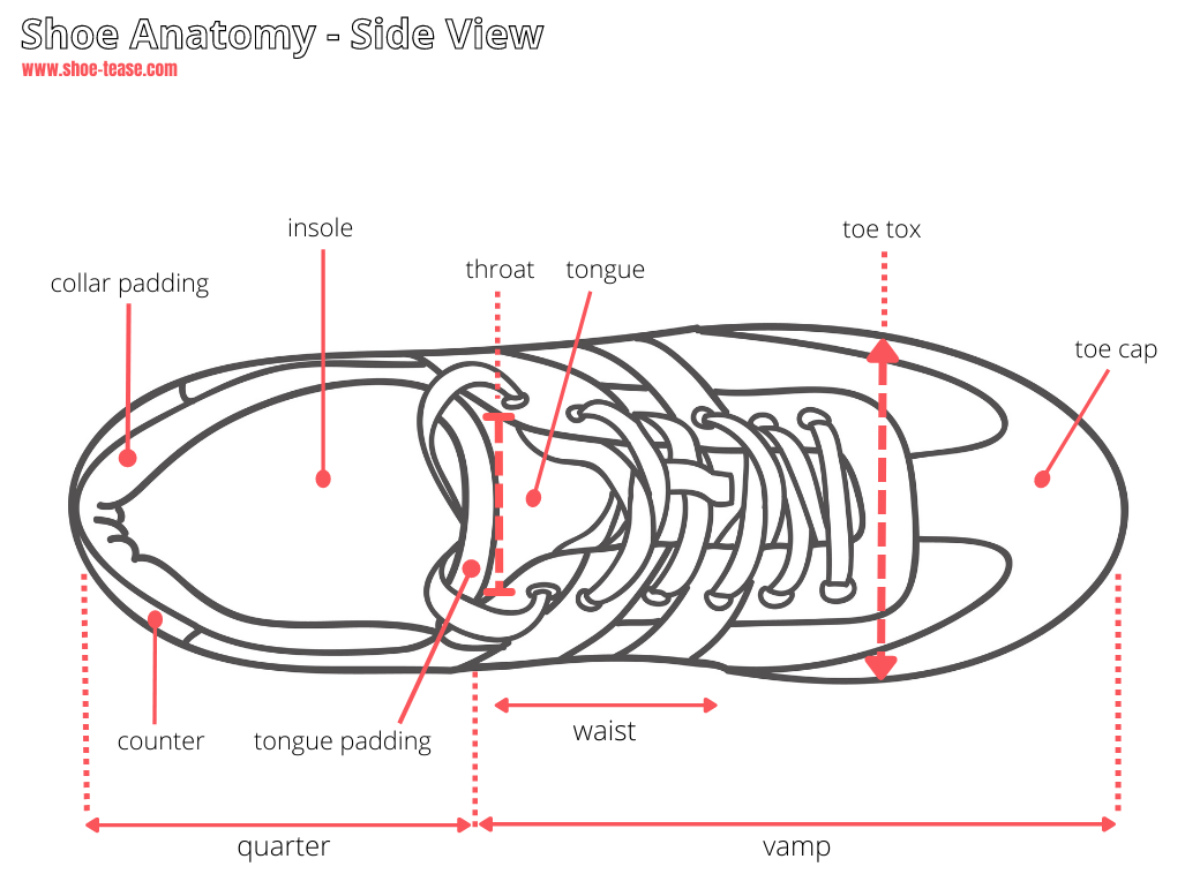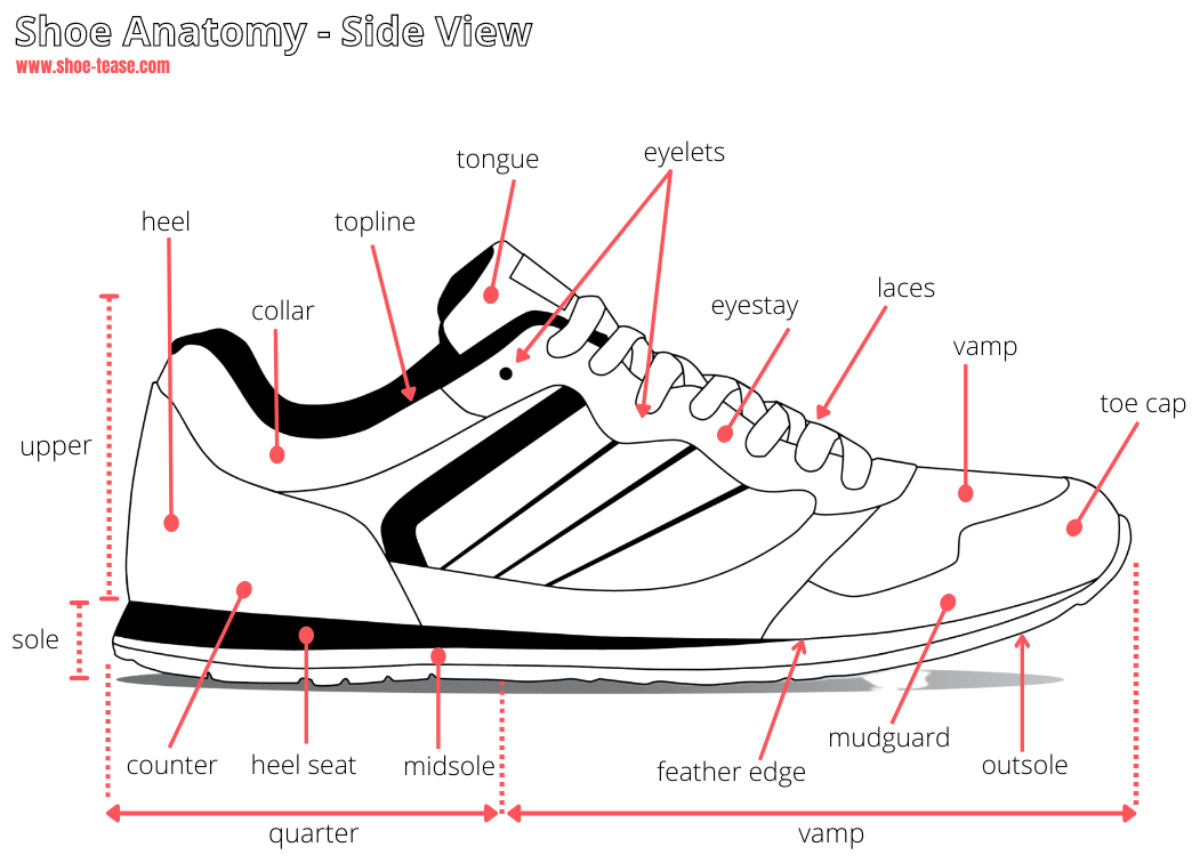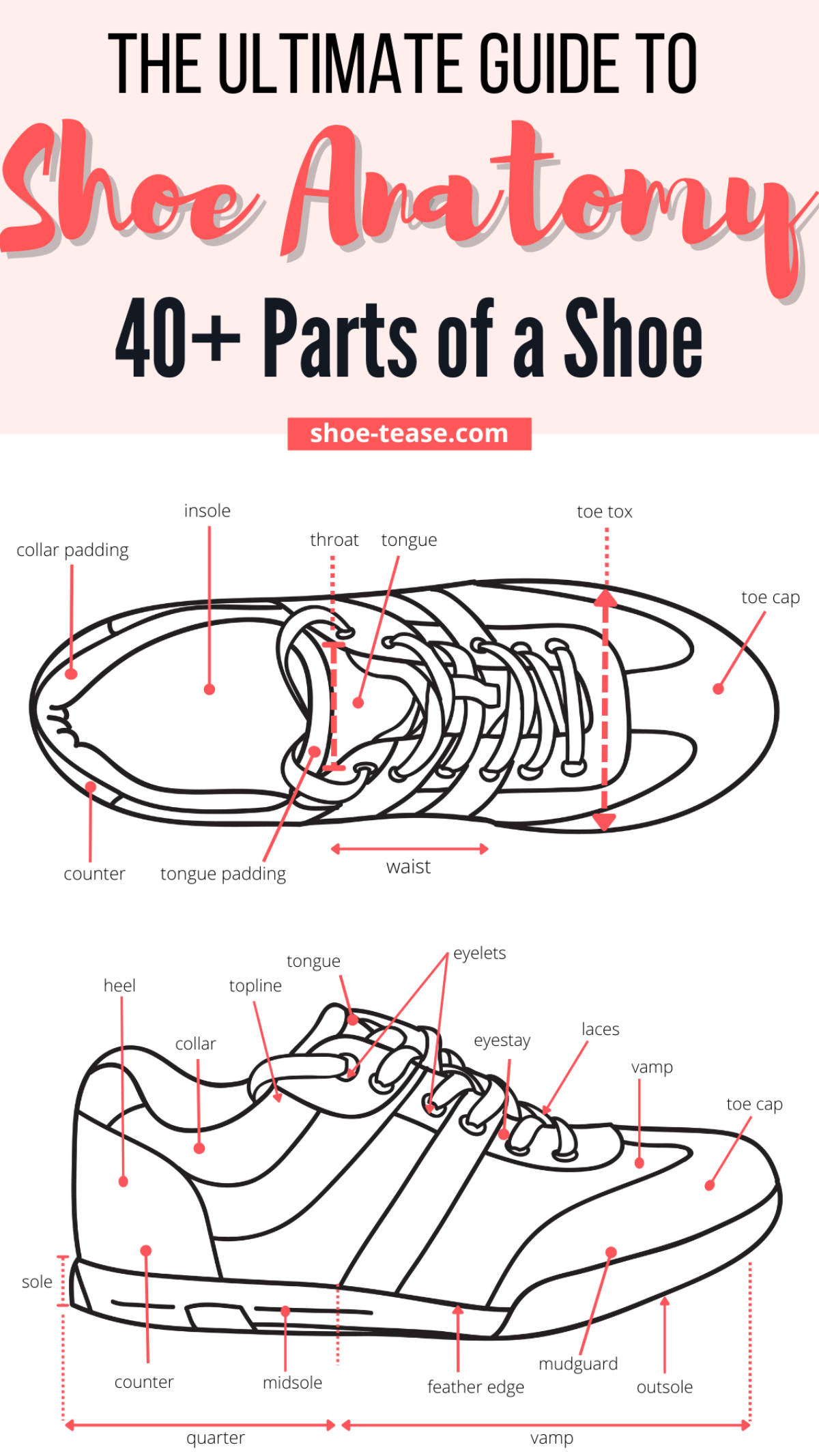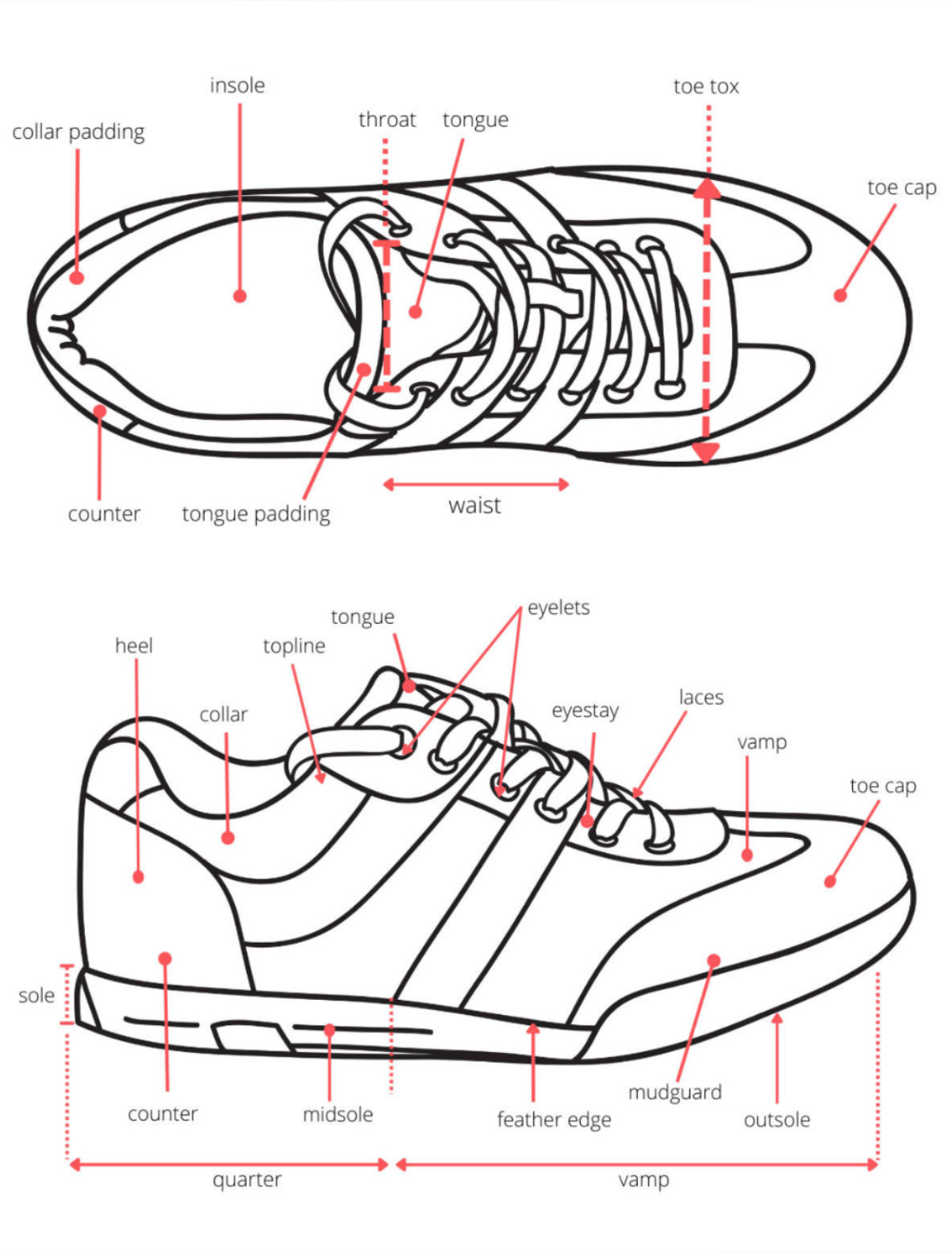If you wonder how many different parts make up a shoe, well – there are a lot. Over 40, actually!
Since I’m often citing parts of the different types of shoes, in my many posts, I thought it was time to write a comprehensive guide about shoe anatomy.
Worth noting that not every shoe will have every shoe component listed – some will have less, others will have more, as each shoe varies in style, design and construction.
I hope the various illustrated shoe parts, along with names and explanations, will help clarify general shoe terminology for you, so you will know where all the parts of a shoe are located!
Deepen Your Shoe Knowledge with All of its Anatomy!
Below are over 40 different parts of a shoe divided into 3 parts: the top exterior, bottom and interior components.
Looking for parts of a high heel shoe, specifically? Then check out that post, here.
PART 1 – The Shoe Upper (Top Parts)

Starting with the shoe upper, and that's exactly what it sounds like: the literal upper part of a shoe, aka the shoe top. The upper shoe parts include all parts above the sole.
In the shoe-making process, the shoe uppers are stitched together to form one piece, then attached to the sole.
The upper is then connected to the sole using glue and/or stitching or bound to the upper by a process called vulcanization. You will see this type of outsole mostly on sneakers. For example, Converse Chuck Taylors.
Below are 22 different parts that can form the external shoe upper:

Shoe Vamp
The vamp of a shoe is the front panel of a shoe. You can find it in the front area of the upper, from the toe tip until the back quarter (before the heel area).
For some shoe styles, the vamp and quarter are 1 piece of material, while other shoes are constructed of separate pieces of material stitched together.
Quarter
The quarter area of a shoe is located beginning from the back and side of the upper, to where the vamp begins. It also includes the heel area.
Collar
The shoe collar is the edge surrounding the upper back and top of the quarter, where you insert your foot. It is padded to provide ankle support.
Achilles Notch
A V or U -shaped cut in the rear collar of the shoe gives more space for movement to the Achilles tendon while walking or to run.
Topline
The topline of a shoe is found at the top edge of the upper, above the collar. It sometimes has a visible stitch where the outer upper, lining and any padding are held together.
Counter
The counter is a section of material at the rear part of the shoe that provides support and shape right behind the foot’s back heel.
Stiffener
A sturdy but light material is placed between the upper and its lining. It’s meant to provide shape and structure to the shoe counter and prevent it from bowing. It also adds support to the heel of the foot.
Backstay
Found on the shoe’s counter, a backstay is a strip of material that runs vertically from above the heel, to the counter and often up to the topline.
Breast
Part of the shoe upper is located under the arch and instep of the foot.
Heel Tab
Found on many Chelsea boots and sneakers, a heel tab is a fabric loop secured to the shoe's backstay. It usually serves an aesthetic function, but the technical use is to pull the shoes, sneakers or boots onto the feet.
Throat
You can find the throat of a shoe in the vamp section beside the toe cap. It’s the opening in certain shoe styles such as sneakers and oxfords, the shoe tongue is attached to bordered by an eyestay, when there is one.
Waist
The shoe waist is located in the middle of the shoe where it is usually most narrow. Shoes that offer better arch support have a more cinched ‘waist’.
Tongue
The shoe tongue is a long piece of material found under eyestays of lace-up and some slip-on shoes, attached to the vamp. It sits at the top of the foot, protecting it from having laces rub against the forefront of the foot.
Eyestay
An eyestay is found at the top of the shoe’s vamp. This is where the eyelets are secured and laces pass through. The eyestay is often reinforced or padded.
Eyelet
The holes in which laces pass through. You will often find them reinforced with a circular plastic or metal rivet to prevent the eyelet holes from ripping. The number of eyelets on a shoe depends on the specific shoe style and design.
Laces
Also called shoestrings, shoelaces pass through eyelets on the eyestay. Their purpose is to tighten the shoes on the feet. There are various types of shoelace materials used: from cotton to elastic, to flat and rounded.
Apron
An apron can be found on a shoe called an apron toe shoe. It is a piece of shoe material that covers the top of the front shoe. It is stitched to the lower vamp, around the lacing.
Shoe aprons can be featured on particular loafers, oxfords, derby shoes and boot styles.
Saddle
A piece of material shaped like a saddle, that is stitched across the shoe’s vamp on a saddle shoe. It is often a contrasting color or material to the rest of the vamp.
Toe Cap
A shoe’s toe cap is a piece of material varying in shape that covers the toe area of a shoe. It is often used to reinforce the toe area. However, it can often be purely decorative.
Toebox
Found on the vamp area of a shoe, the toebox is the part of a shoe that covers and protects the toes on close-toe shoes. These can vary in shape, such as a rounded, almond shape, square or pointed toebox.
Mudguard
A strip of material that runs along the edge of the sole, just above it. It serves either to protect against dirt and water, as a decoration, or both. Mostly found on sneakers.
Feather Edge
The edge where the shoe upper meets and is attached to the sole. It can be rounded – feathered – or have an edge.
PART 2 – The Bottom Parts
The bottom parts of a shoe are all of the shoe parts that can be found under the upper construction, below the foot. Yes, we're mostly talking about soles and heels!
Shoe or boot bottoms can be comprised of any of the 7 parts, below:
Shoe Sole
If you're curious what the bottom of a shoe is called, this is the section for you! The shoe sole is the bottom of a shoe found under the upper.
A shoe sole is comprised of 3 parts: the outsole, midsole and insole, all of which sit under the foot.
Outsole
The outsole, commonly known as the ‘sole’, is the external part of a sole that touches the ground. Outsoles can are constructed from many durable materials such as rubber, leather and hybrid materials with non-slip properties.
Insole
Also called the inner sole, this is the interior part of the sole where the foot bottoms touch. Insoles provide foot sole and arch support. Some insoles are removable, allowing the wearer to insert orthotics or a preferred insole.
Midsole
The middle part of the shoe sole is between the insole and outsole. Not all shoe types have a midsole, although many sneakers do, as it provides cushioning and bounce.
Welt
A welt is a strip of material – often leather on dress shoes – that is stitched around the edge of the upper’s base, onto which the outer sole is sewn.
It is used to secure the upper to the sole better. Not all shoes have welts, but most higher-end and well-constructed shoes do. Fun fact: Goodyear Jr. invented it.
Heel
The heel is the back part of the shoe that elevates the foot's heel. It is used for balance or aesthetics, but often for both.
Heel Seat
The top portion of the heel is sandwiched between the heel and the upper. Not all shoes have them, but many sneakers do.
Heel Cap
A heel cap is found on the base of a women’s higher heel shoe, from block heels to stilettos, sandals and slippers. It protects the base of the heel, increasing traction and stability.
Part 3 – The Interior Anatomy
Interested in the interior construction of a shoe? Below are the main parts of a shoe anatomy’s “insides”. It includes 15 parts in various materials used to cushion, shape, and make shoes more comfortable.
Insole
A shoe’s insole is the inner layer the foot touches inside the shoe. It extends from the shoe’s toe to the shoe heel. It is a few millimeters thick and often made of leather or faux leather in dress shoes and various other materials for sneakers.
Stiffener
Sturdy but light material is placed between the upper and its lining. It’s meant to provide shape and structure to the shoe counter and prevent it from bowing. It also adds support to the heel of the foot.
Shank
A shoe’s shank is a rigid material, often wood, plastic or metal, found between the outsole and insole. It helps support the heel counter and the wearer’s feet.
Collar Padding
Padding is found under the collar between the lining and shoe upper to provide comfort around the ankles.
Counter Pads
Padding is added around the shoe’s counter to increase comfort and support in the area.
Internal Heel Counter
Part of the shoe’s sole structure is often stitched on to support the wearer’s heel. It is often made of plastic in running shoes, which helps keep the heel in position when moving.
Shoe Lining
A material that lines the inside part of the shoes where the feet come in direct contact. The shoe lining increases comfort and is often made of a softer material like leather, covering the rough edges of the interior construction of the shoe.
Counter lining
A material used to line the counter back of the shoe.
Tongue Lining
A material used to line the inside of the tongue of the shoe.
Vamp Lining
A material used to line the inside of the shoe’s vamp, aka the front portion of the shoe.
Topline lining
A material used to line the top of the shoe.
Tongue Lining
A material used to line the bottom-facing part of the shoe’s tongue.
Tongue Padding
A soft material used to pad the tongue of the shoe, to add cushioning and comfort to the wearer.
Toe Puff
Often referred to as simply the puff, it is soft material placed between the upper and shoe lining. It provides shape to the toe area, also prevents stretching and adds stability to the shoe.
RELATED POSTS:
Final Thoughts All the Parts that Make up a Shoe

It appears that I’ve given you plenty of shoe parts for thought when it comes to shoe anatomy! I hope you feel like you have a solid grasp of the various parts of a shoe.
Of course, all shoes are different and some will have parts that others do not. This is especially true when speaking about boots, women’s high heels, and sneakers. Many shoes also have added aesthetic elements such as tassels, buckles and added stitching.
The reason shoes – especially well-made shoes – are a costlier accessory is due to all the components it takes to construct them with.
In addition, they need to be more durable than a purse as they literally drag and stomp on the ground and are exposed to many more elements, with each wear.
That's why learning how to care for them is key so we can make them last longer and have them look their best. Conditioning, waterproofing, resoling, re-heeling, and replacing laces and heel caps are often part of that maintenance.
Read more about how to care for shoes, or check out more related posts below!
More Post About Shoes:
xo ShoeTease
Cristina is the chief editor & shoe expert at ShoeTease. As a seasoned stylist and women's fashion & shoe designer with over 20 years of experience, Cristina's here to guide you on your fashion journey! Learn more.
This post may contain affiliate links. ShoeTease may earn a small commission if you click through and/or make a purchase. Thanks for your support!

I had ankle fusion surgery and wear a rigid AFO on my right foot. Do you know of anywhere to buy different left and right sized shoes? I also need a higher/roomier space where the laces end before the toe box. That leather strap across the shoe blocks the brace.
Hi Chris, I believe Zappos offers this service in the US. I hope this helps!
If you’re able, you might want to make a correction to the first image, as it says “toe tox” rather than “toe box” or “toebox”. Otherwise very informative.
Hi Shawn, thanks so much for the kind words and the heads up. I’ll update that ASAP>